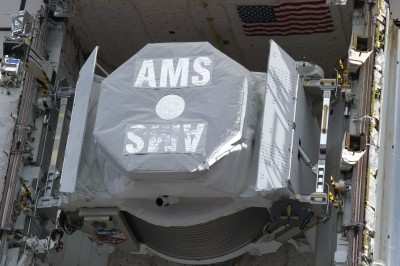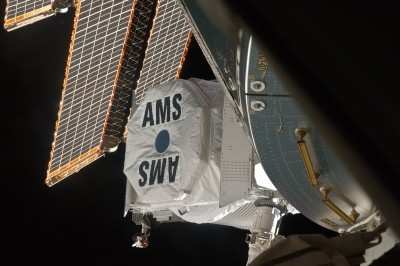Wed, May 25, 2011
Over 500 Scientists From 16 Countries Developed The Device
Four days after launching aboard space shuttle Endeavour, the
Alpha Magnetic Spectrometer (AMS-02) has been successfully
installed on the International Space Station (ISS). The AMS-02 is a
state-of-the-art particle physics detector designed to operate as
an external module on the International Space Station. It will use
the unique environment of space to study the universe and its
origin by searching for antimatter and dark matter

The AMS-02 contains sensors that measure cosmic radiation and
detect dark matter or antimatter. The sensors should function well
for at least ten years and are maintained at a fixed temperature.
To ensure equitable temperature conditions, a highly advanced
cooling system was developed based on two-stage CO2 cooling. The
instrument, which was developed by a team of some 500 scientists
hailing from 56 scientific institutes in 16 countries, was
transported to ISS aboard space shuttle Endeavour in its final
flight.

The Alpha Magnetic Spectrometer - 02 (AMS-02) is a
state-of-the-art particle physics detector constructed, tested and
operated by an international team. The AMS-02 uses the unique
environment of space to advance knowledge of the universe and lead
to the understanding of the universe's origin by searching for
antimatter, dark matter and measuring cosmic rays.
NASA says the AMS-02 will provide a plethora of cosmic ray data
that will help to advance and perhaps redefine much of what we know
about the Low Earth Orbit space radiation environment.

This unique scientific mission of exploration seeks to
understand fundamental issues shared by physics, astrophysics and
cosmology on the origin and structure of the universe. Although the
AMS-02 is specifically looking for antimatter and dark matter, as
the largest magnetic spectrometer in space, AMS-02 has and will
collect information from cosmic sources emanating from stars and
galaxies millions of light years beyond the Milky Way.

The instrument is reportedly operating normally, and has
reportedly already tracked its first particles from ISS.
More News
Aero Linx: Model Aeronautical Association of Australia MAAA clubs are about fun flying, camaraderie and community. For over 75 years, the MAAA has been Australia’s largest fl>[...]
Touchdown Zone Lighting Two rows of transverse light bars located symmetrically about the runway centerline normally at 100 foot intervals. The basic system extends 3,000 feet alon>[...]
“Discovery and innovation are central to our mission at Virgin Galactic. We’re excited to build on our successful record of facilitating scientific experiments in subor>[...]
How To Get A Story On Aero-TV News/Feature Programming How do I submit a story idea or lead to Aero-TV? If you would like to submit a story idea or lead, please contact Jim Campbel>[...]
Student Pilot Reported That During Rotation, “All Of A Sudden The Back Of The Plane Kicked To The Right..." Analysis: The student pilot reported that during rotation, “>[...]
 ANN's Daily Aero-Linx (05.02.24)
ANN's Daily Aero-Linx (05.02.24) ANN's Daily Aero-Term (05.02.24): Touchdown Zone Lighting
ANN's Daily Aero-Term (05.02.24): Touchdown Zone Lighting Aero-News: Quote of the Day (05.02.24)
Aero-News: Quote of the Day (05.02.24) ANN FAQ: Contributing To Aero-TV
ANN FAQ: Contributing To Aero-TV NTSB Final Report: Cirrus Design Corp SR20
NTSB Final Report: Cirrus Design Corp SR20






